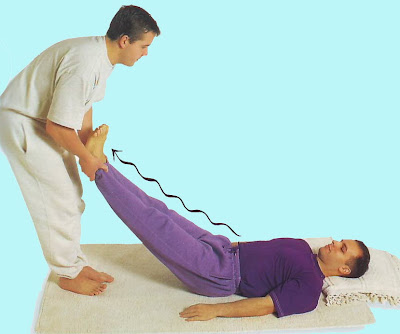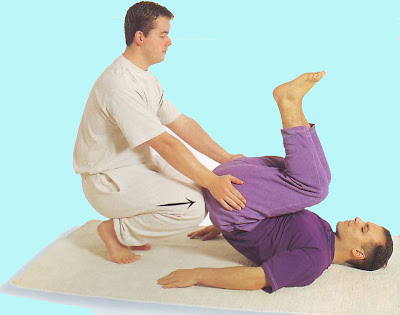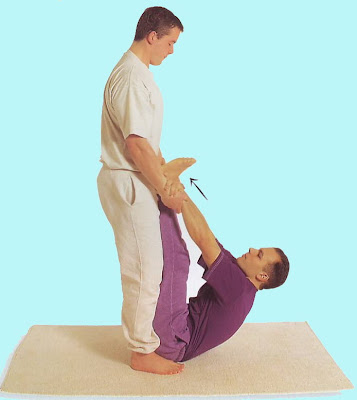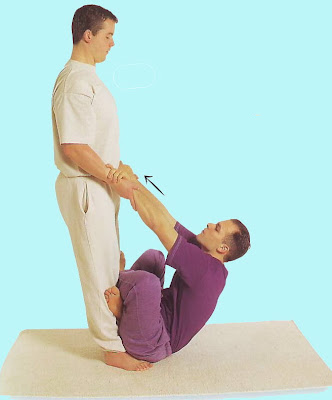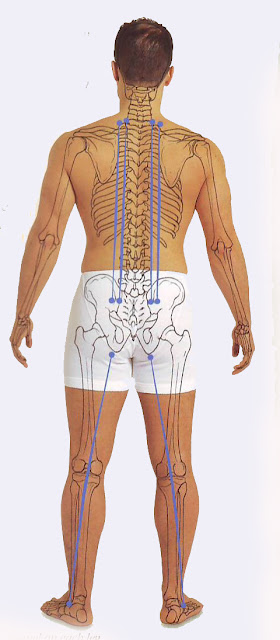 |
- Ÿ l - Chinese Bladder meridian. This starts between the Achilles tendon and the outer ankle bone and runs up the back of the leg approximately on the midline to the lower border of the buttocks.
- Ÿ l - Thai bodywork uses two back Sen channels along the Chinese Bladder meridian. There are two lines on each side of the spine. The inner one is about two finger-widths and the outer one four finger-widths from the midline of the spine.
- When blood flow into the legs is interrupted, the entire circulation including lymphatic drainage is reduced or completely stopped. The swift rush of blood into the legs is accompanied by a sudden spread of warmth down to the feet as full circulation is restored. After this treatment the legs feel very light.

- 1. PRESSING THE
INNER FEET & LEGS
Stretched: Adductors - 2. LEG BLOOD STOP
Pressed: Adductors
3. BOW & ARROW SPINAL
TWIST
Tuck your right heel behind
your partner’s left flexed knee and grasp and pull his left forearm towards you,
keeping his left leg firmly located on the mat. Now lean across and grasp under
his left shoulder with both hands and pull it up towards
you.
Pull along the shoulder and
down your partner’s side with alternate hand movements which should be kept
slow and rhythmical.
- Treats lower back pain,
improves spinal mobility and aligns the spine.
Do not use on those who have had surgery on the lower back
4. ROTATING THE HIPS
-
Has a soothing effect on
those who experience stiffness in the hip region, sciatica and lower back pain.
In addition to the rotation imposed on the hip joint, a twisting action on the
lumbar vertebral also occurs and this relaxes muscles in the hip.
- 3. BOW &
ARROW SPINAL TWIST
Stretched:
Quadatus lumborum, rhomboideus major and minor, levator acapulae, iliacus,
psoas major
- 4. ROTATING THE
HIPS
Stretched: Gluteus maximus, quadriceps (slight stretch),
quadratus lumborum
5. SHAKING THE LEGS
Grasp your partner’s
ankles, lean back slightly to create traction and shake his legs up and down
rapidly with a small-amplitude movement. Shake the legs ten to twenty times.
6. SWINGING THE LEGS
- Essential for those suffering
from lower back pain and sciatica. These techniques can also be used on those
who suffer from varicose veins.
7. ROCKING & ROLLING THE
BACK
- Helps to ease middle and
upper back pain.
Care must be taken not to
over-stretch anyone to whom you are giving massage for the first time.
8. THE PLOUGH
Spread your partner’s legs
out into an open ‘V’ and step through them to adopt a new position astride his
body with your feet tucked under his armpits. Bend your knees slightly towards
the mid-lime, increase the ‘V’ ankle between his legs and draw them around your
knees. Press his feet together and then press lightly downwards. Hold for a few
seconds, and then open his legs again, draw them back around your legs and push
the feet forward and down a little further in the direction of his head. In a
very flexible person the feet will touch the floor. Repeat this until you find
the most extreme position that is comfortable for him. Hold the position for at
least ten seconds.

9. KNEEING THE BACKS OF THE
THIGHS
As your partner is released
from the previous position, retain your hold on his feet and step back through
his legs again. Hold his feet so that his legs are slightly bent. Using your
body weight, press both knees simultaneously into the backs of his thighs
whilst at the same time, pushing his feet forward. Press progressively along
the entire length of his thighs.
- This simple technique is
good for suffers of sciatica and those who experience problems with their
hamstring muscles.
- Aids mobility of the hip
joints and counters pain in the pelvic region and lower back.
Do not use this exercise on
the elderly and wait for at least two hours if your partner has eaten a large
meal.
- 7. ROCKING &
ROLLING THE BACK
Stretched: Erector spinae, gastrocnemius
- 8. THE PLOUGH
Stretched: Adductors, soleus, hamstrings, gluteus maximus,
erector spinae
- 9. KNEEING THE
BACKS OF THE THIGHS
Stretched: Erector spinae, gluteus maximus
Pressed: Hamstrings, lower part of gluteus maximus
10. KNEEING THE BUTTOCKS
- Treats sciatica pain.
11. SHINNING THE THIGHS
- Another excellent treatment
for sciatica; also very effective for myofascial release around the hamstrings,
particularly for those who do a great deal of sport.
12. THE HALF BRIDGE
- Increases
blood flow to the head and neck to give your partner an alert and lively
feeling.
- Eases
lower back pain.
Do not use this technique
on those with cardiac problems and high blood pressure.
- 10. KNEEING THE
BUTTOCKS
Stretched: Erector spinae, Gluteus maximus
Pressed: Gluteus maximus
- 11. SHINNING THE
THIGHS
Stretched: Gluteus maximus
Pressed: Hamstrings
- 12. THE HALF
BRIDGE
Stretched: Quadriceps, rectus abdominis, erector spinae
13. INTIMATE BACK STRETCH
- Treats tension and pain in
the lower back.
14. LIFTING HEAD TO STRAIGHT
KNEES
Align your partner’s legs
firmly against the front of your own and lean forward to grasp each arm around
the wrist. Lean your weight backwards and pull his upper body forwards and
upwards.
15. LIFTING HEAD TO CROSSED
KNEES
- Improves
shoulder and hip mobility. All the stretched muscles are relaxed.
- Can
ease sciatic pain.
Good flexibility when the
legs are straight is no necessarily an accurate guide to your partner’s
flexibility when his legs are crossed. Some people have very restricted lateral
movement in their hips and/or ankles but good mobility in the forward/backward
direction.
- Treats lower back pain, improves spinal mobility and aligns the spine.
- Has a soothing effect on those who experience stiffness in the hip region, sciatica and lower back pain. In addition to the rotation imposed on the hip joint, a twisting action on the lumbar vertebral also occurs and this relaxes muscles in the hip.
- 3. BOW &
ARROW SPINAL TWIST
Stretched: Quadatus lumborum, rhomboideus major and minor, levator acapulae, iliacus, psoas major - 4. ROTATING THE
HIPS
Stretched: Gluteus maximus, quadriceps (slight stretch), quadratus lumborum
- Essential for those suffering from lower back pain and sciatica. These techniques can also be used on those who suffer from varicose veins.
- Helps to ease middle and upper back pain.


9. KNEEING THE BACKS OF THE THIGHS
- This simple technique is good for suffers of sciatica and those who experience problems with their hamstring muscles.
- Aids mobility of the hip joints and counters pain in the pelvic region and lower back.
- 7. ROCKING &
ROLLING THE BACK
Stretched: Erector spinae, gastrocnemius
- 8. THE PLOUGH
Stretched: Adductors, soleus, hamstrings, gluteus maximus, erector spinae
- 9. KNEEING THE
BACKS OF THE THIGHS
Stretched: Erector spinae, gluteus maximus
Pressed: Hamstrings, lower part of gluteus maximus
- Treats sciatica pain.
- Another excellent treatment for sciatica; also very effective for myofascial release around the hamstrings, particularly for those who do a great deal of sport.
- Increases blood flow to the head and neck to give your partner an alert and lively feeling.
- Eases lower back pain.
- 10. KNEEING THE
BUTTOCKS
Stretched: Erector spinae, Gluteus maximus
Pressed: Gluteus maximus
- 11. SHINNING THE
THIGHS
Stretched: Gluteus maximus
Pressed: Hamstrings
- 12. THE HALF
BRIDGE
Stretched: Quadriceps, rectus abdominis, erector spinae
- Treats tension and pain in the lower back.
- Improves shoulder and hip mobility. All the stretched muscles are relaxed.
- Can ease sciatic pain.








